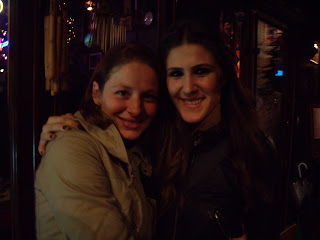
We got a few last days in Istanbul before heading our separate ways for the holidays. The second time around we were old pros: we stayed in the cool side of town, chilled with the locals, and checked the last of the major tourist attractions off our list.

First on the agenda was Dolmabahce Palace, where the sultans moved when Topkapi began to cramp their style. It did not disappoint. In terms of ridiculousness and ostentation I think it surpasses Versailles. To the left is the crystal staircase (the banister supports are made of carved rock crystal). Another favorite spot is the modest room allotted for religious ceremonies:

Aaron's favorite find in the treasuries? A spiff hide-a-way liquor cabinet:

Mine? The demitasse, duh.

We spent a day wandering around our neighborhood, Beyoglu, which is home to some really fun antique shops. Most were selling kitchy 50's retro stuff or finer goods from Ottoman days, but
A la Turca, a four story town house meticulously decorated with carpets and other Turkish treasures, was where Aaron and I lost our heads.

Every surface was covered with the classiest examples of the most stereotypical antiques. Interspersed were things we'd never dreamed of: deer antler cutlery, ten foot tall wooden birdcages, ostrich egg bowls. It was a kind of high-brow hipster Neverland.
Better still we got keyed in to the local music scene over two evenings with an old schoolmate from Castilleja, Belkis Boyacigillar. Belkis has been working for Istanbul-based entertainment group Babylon since college and introduced us to Turkey's hottest selling recording artist (a clarinetist) who was in town performing with the saxophonist from one of Aaron's haunts, NuBlu.

A few last notes. First, I think I've yet to mention the ever present evil eye in any of my posts from Turkey. We saw this symbol on everything from doilies to jewelry to doorknobs. A group of small girls in Konya waved them at us for protection while peppering us with questions about America. This was my favorite use though:

And while we're on food, the candied quince with clotted cream we ate upon our return to the pudding shop Saray deserve some recognition. Gorgeous, no?

xoxo Jessie